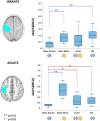Cortical Processing of Multimodal Sensory Learning in Human Neonates
- PMID: 33207366
- PMCID: PMC7869081
- DOI: 10.1093/cercor/bhaa340
Cortical Processing of Multimodal Sensory Learning in Human Neonates
Abstract
Following birth, infants must immediately process and rapidly adapt to the array of unknown sensory experiences associated with their new ex-utero environment. However, although it is known that unimodal stimuli induce activity in the corresponding primary sensory cortices of the newborn brain, it is unclear how multimodal stimuli are processed and integrated across modalities. The latter is essential for learning and understanding environmental contingencies through encoding relationships between sensory experiences; and ultimately likely subserves development of life-long skills such as speech and language. Here, for the first time, we map the intracerebral processing which underlies auditory-sensorimotor classical conditioning in a group of 13 neonates (median gestational age at birth: 38 weeks + 4 days, range: 32 weeks + 2 days to 41 weeks + 6 days; median postmenstrual age at scan: 40 weeks + 5 days, range: 38 weeks + 3 days to 42 weeks + 1 days) with blood-oxygen-level-dependent (BOLD) functional magnetic resonance imaging (MRI) and magnetic resonance (MR) compatible robotics. We demonstrate that classical conditioning can induce crossmodal changes within putative unimodal sensory cortex even in the absence of its archetypal substrate. Our results also suggest that multimodal learning is associated with network wide activity within the conditioned neural system. These findings suggest that in early life, external multimodal sensory stimulation and integration shapes activity in the developing cortex and may influence its associated functional network architecture.
Keywords: brain plasticity; classical conditioning; functional MRI; multisensory integration; neonate.
© The Author(s) 2020. Published by Oxford University Press.
Figures




References
-
- Allievi AG, Melendez-Calderon A, Arichi T, Edwards AD, Burdet E. 2013. An fMRI compatible wrist robotic interface to study brain development in neonates. Ann Biomed Eng. 41:1181–1192. - PubMed
Publication types
MeSH terms
Grants and funding
LinkOut - more resources
Full Text Sources

